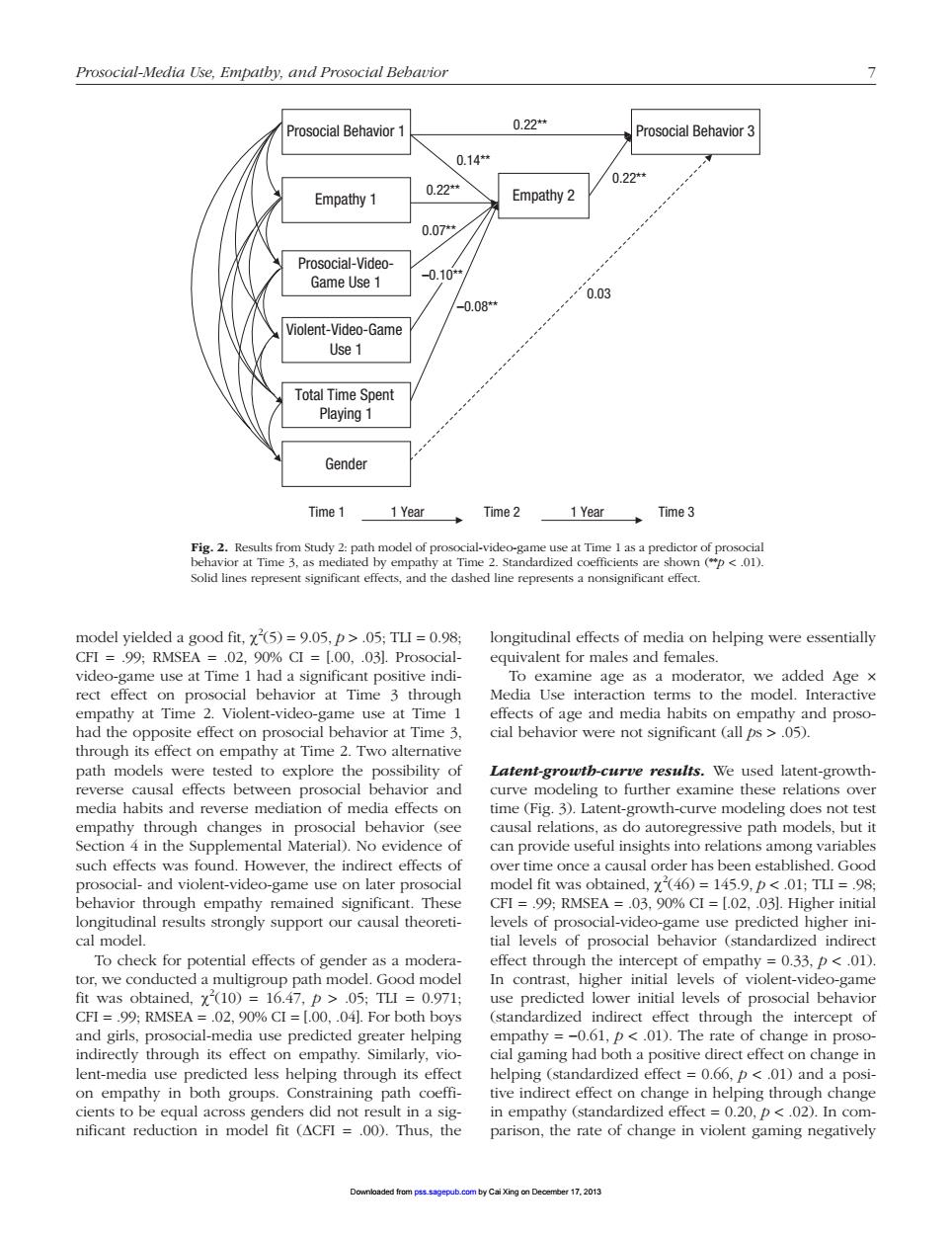正在加载图片...

Prosocial-Media Use,Empatby,and Prosocial Bebavior Behavior 0.22 、0.14 0.22 /0.22 Empathy 1 Empathy 2 0.074 Prosocial-Video -0.10 Game Use 1 0.08* 0.03 Violent-Video-Game Total Time Spent Playing 1 Gender 1Year Time 2 1 Year Time 3 odlyelteda RMSEA odft,x5)=9.05,p>.05;T=0.98 00.03L video. ame use at Time 1 had a significant positive indi- Toeamine age as a moderator,we added Agex rect effect on prosocial behavior at Time 3 through Media Use interaction terms to the model.Interactive Violent-video-game use at Time path models wer tested t explore the of wth curze resuits We used latent growth reverse causal effects between prosocial behavior and urveeinuer heev media habits and reverse mediation of media effects on time (Fig.3).Latent-growth-curve modeling does not tes empathy (se causal rea oregre ssive path mo els.D such effects was fo und.However,the indirect effects of prosocial-and violent-video-game use on later prosocial model fit was obtained,2(46)=145.9,p<.01;TLI=.98 behavior through empathy remained significant.These CFI=99;RMSEA =03,90%CI =1.02,.031.Higher initial results strongly support our causal theoreti- To check for notential effects of a effect through the inte athy=0.33.b<.01 tor,we conducted a multigroup path model.Good model In contrast.higher initial levels of violent-video-game fit was obtained,y(10) p> 05:11I=0.971: use predicted lower initial levels of prosocial behavio CF i:RMSE 02, 0 For both the intercept o Similarly,vio ing had both a t ositive direct effect on change in lent-media use predicted less helping through its effect helping (standardized effect =0.66,p<.01 and a posi- on empathy in both groups.Cons training path coeffi- tive indirect effect on change in helping through change not ntanrdized 0,P9 In hange riolen 17.2013 Prosocial-Media Use, Empathy, and Prosocial Behavior 7 model yielded a good fit, χ2 (5) = 9.05, p > .05; TLI = 0.98; CFI = .99; RMSEA = .02, 90% CI = [.00, .03]. Prosocialvideo-game use at Time 1 had a significant positive indirect effect on prosocial behavior at Time 3 through empathy at Time 2. Violent-video-game use at Time 1 had the opposite effect on prosocial behavior at Time 3, through its effect on empathy at Time 2. Two alternative path models were tested to explore the possibility of reverse causal effects between prosocial behavior and media habits and reverse mediation of media effects on empathy through changes in prosocial behavior (see Section 4 in the Supplemental Material). No evidence of such effects was found. However, the indirect effects of prosocial- and violent-video-game use on later prosocial behavior through empathy remained significant. These longitudinal results strongly support our causal theoretical model. To check for potential effects of gender as a moderator, we conducted a multigroup path model. Good model fit was obtained, χ2 (10) = 16.47, p > .05; TLI = 0.971; CFI = .99; RMSEA = .02, 90% CI = [.00, .04]. For both boys and girls, prosocial-media use predicted greater helping indirectly through its effect on empathy. Similarly, violent-media use predicted less helping through its effect on empathy in both groups. Constraining path coefficients to be equal across genders did not result in a significant reduction in model fit (ΔCFI = .00). Thus, the longitudinal effects of media on helping were essentially equivalent for males and females. To examine age as a moderator, we added Age × Media Use interaction terms to the model. Interactive effects of age and media habits on empathy and prosocial behavior were not significant (all ps > .05). Latent-growth-curve results. We used latent-growthcurve modeling to further examine these relations over time (Fig. 3). Latent-growth-curve modeling does not test causal relations, as do autoregressive path models, but it can provide useful insights into relations among variables over time once a causal order has been established. Good model fit was obtained, χ2 (46) = 145.9, p < .01; TLI = .98; CFI = .99; RMSEA = .03, 90% CI = [.02, .03]. Higher initial levels of prosocial-video-game use predicted higher initial levels of prosocial behavior (standardized indirect effect through the intercept of empathy = 0.33, p < .01). In contrast, higher initial levels of violent-video-game use predicted lower initial levels of prosocial behavior (standardized indirect effect through the intercept of empathy = −0.61, p < .01). The rate of change in prosocial gaming had both a positive direct effect on change in helping (standardized effect = 0.66, p < .01) and a positive indirect effect on change in helping through change in empathy (standardized effect = 0.20, p < .02). In comparison, the rate of change in violent gaming negatively 1 Year 1 Year Prosocial Behavior 1 Prosocial Behavior 3 Empathy 2 Violent-Video-Game Use 1 Prosocial-VideoGame Use 1 0.22** 0.22** 0.22** 0.14** 0.07** 0.03 Time 1 Time 2 Time 3 Gender –0.08** Empathy 1 Total Time Spent Playing 1 –0.10** Fig. 2. Results from Study 2: path model of prosocial-video-game use at Time 1 as a predictor of prosocial behavior at Time 3, as mediated by empathy at Time 2. Standardized coefficients are shown (**p < .01). Solid lines represent significant effects, and the dashed line represents a nonsignificant effect. Downloaded from pss.sagepub.com by Cai Xing on December 17, 2013